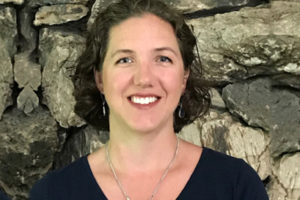One Saturday morning last fall, I randomly – and providentially – discovered a renowned Catholic poet with ties to Cumberland while visiting the city’s historic library. Little did I know then just who Sr. Madeleva Wolff was, nor the impact she would have on my life and the potential impact I might have on continuing her work of promulgating creative writing, especially the art of poetry, as the spiritual tool she believed it to be.
You can learn more about my story of encountering the life and work of Sr. Madeleva and my own efforts to bring her published writings to new life by visiting www.jennylarks.com and signing up for the “Mirroring Madeleva” newsletter.
Sr. Madeleva is only one of a handful of women religious poets recognized for their artistic abilities and contribution to the canon of Catholic literature in the 20th century.
In a book released this month by Nick Ripatrazone, “The Habit of Poetry: The Literary Lives of Nuns in Mid-Century America,” poetry is presented as the language of hearts and minds “and the most perfect way to ponder belief and doubt.” The author proposes that these women’s legacy – three of five with direct ties to Wisconsin – is “notable: that in an increasingly secular world, skilled and inspired work from religious poets can still shine, even as those poets wrestle with their identities and faith.”
Jessica Powers (1905-88) tended the family farmhouse in Mauston until the age of 31, when she moved to New York City to pursuit her art. In 1941, she entered the community of Carmel of the Mother of God near Milwaukee and received the name Sr. Miriam of the Holy Spirit.
Sr. Mary Bernetta (1915-2003), born Roselyn Viola Quinn in Lake Geneva, entered the Franciscan Sister of the Congregation of Our Lady of Lourdes in 1934. She would go on to receive her Ph.D. in English from UW-Madison in 1952.
Both were published poets and recognized as accomplished in their craft.
The third, and most widely known during their time, was Sr. Mary Madeleva, a Sister of the Holy Cross Congregation in South Bend. She was born Mary Evaline Wolff in Cumberland in May 1887 and forever relished her small-town upbringing and cultural exposure within the diverse Catholic immigrant community.
Sr. Madeleva was proud of her connection with the first group of Newman Club students at UW-Madison in the early 1900s – the first of its kind in the nation. She would continue her studies at St. Mary’s College in Notre Dame, Indiana, and there she discover her vocation and where she served as president from 1934 to 1961.
Seeing the need for a graduate program in theology open to women religious and lay people, Sr. Madeleva, who called herself an “unlikely northerner,” was tasked by the U.S. Bishops Conference with founding it, which she did. The School of Sacred Theology at St. Mary’s was opened in 1942 and was the only of its kind for a decade.
Although most widely known for her numerous administrative accomplishments, Sr. Madeleva’s greatest legacy – that of her poetry – is yet largely untapped.
She called poetry an ancient art, “essential to the human spirit” and described her own poetic process as a means of sanctification and prayer. For her, the goal of teaching creative writing was to transmit the wonder of words, rooted in God’s word. In a speech given in 1958, she stated a poet’s goal should be “to take truth from the philosopher and fashion is into a jewel to set it in a form of beauty.”
During the homily at her funeral Mass, given by Fr. John Donahue, SJ, Sr. Madeleva was called “the best-known Catholic sister in the U.S.” during the three decades before Vatican II.
I am thrilled to see her the subject of Ripatrazone’s book and look forward to unveiling more of her story and work both within and beyond the Diocese of Superior in coming months and years.

